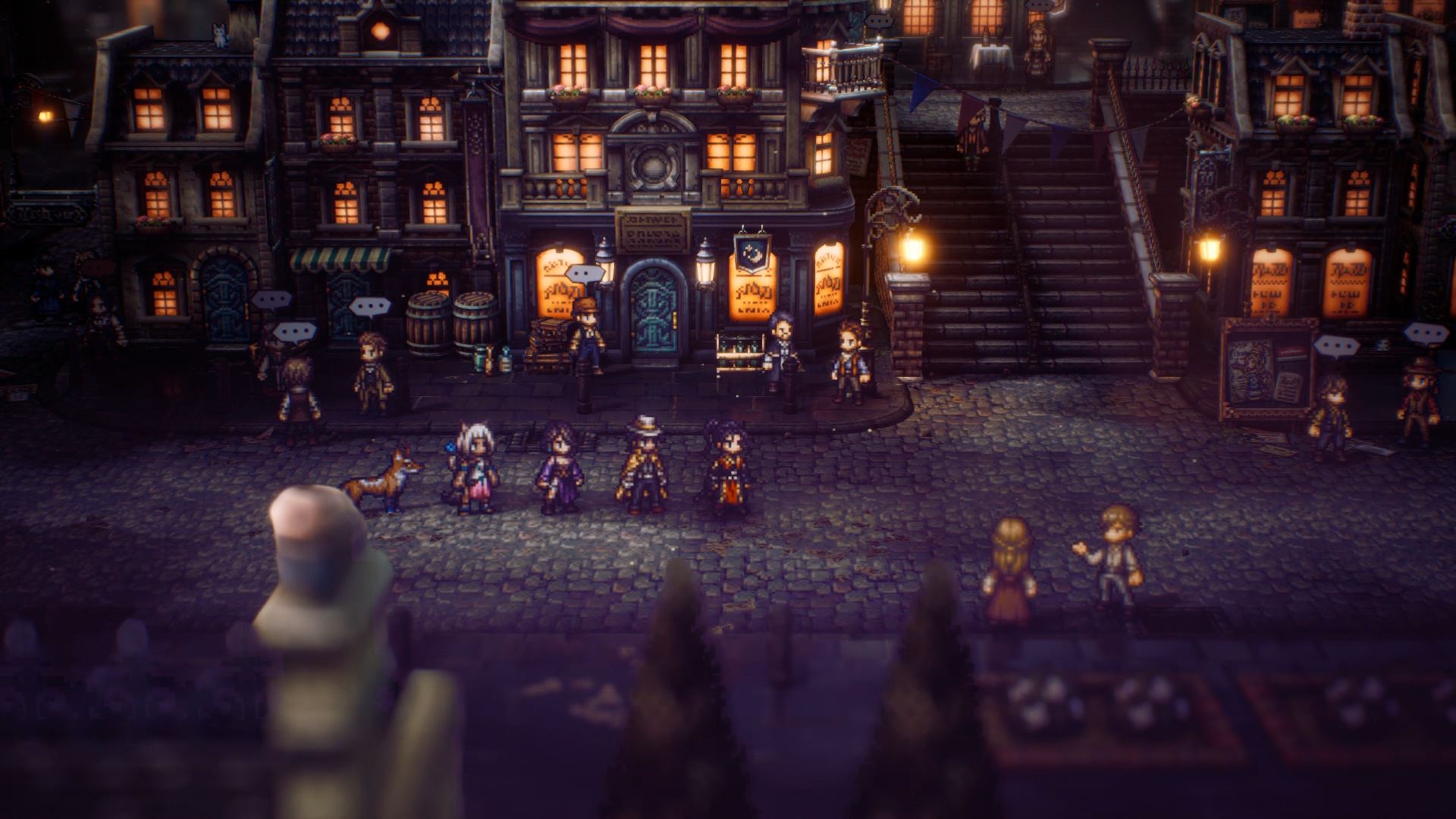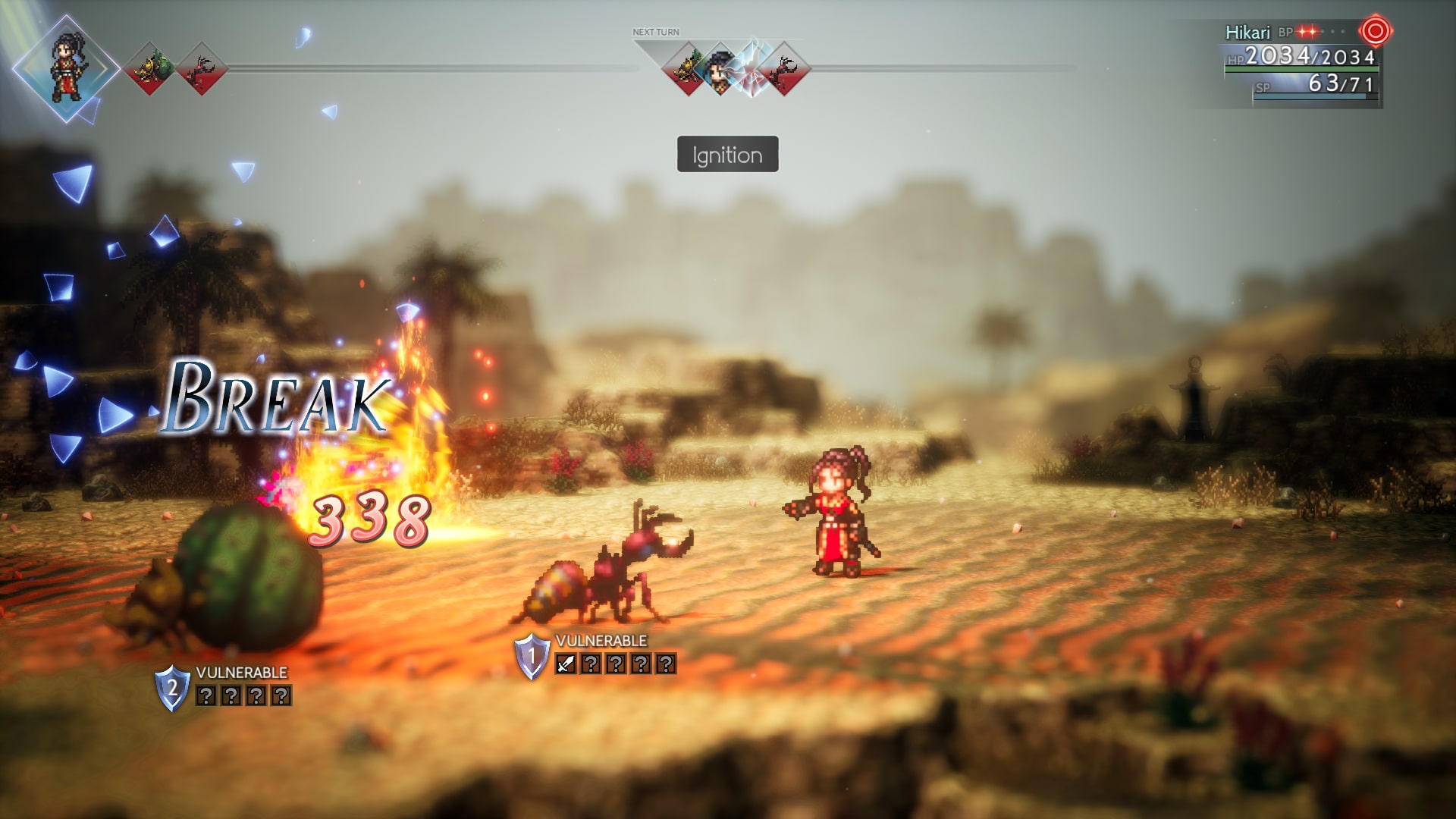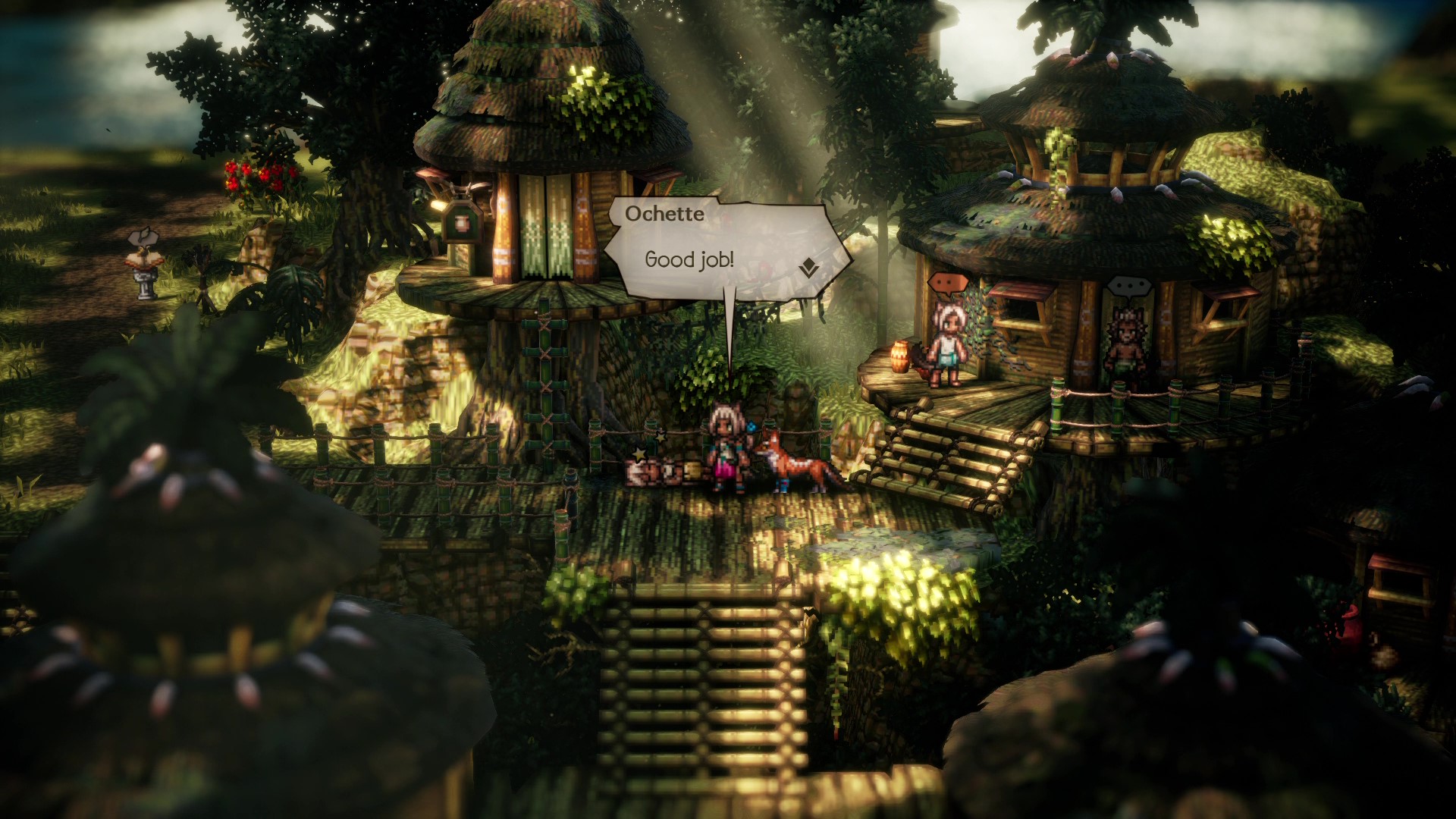Octopath Traveler II is less of a direct sequel to 2018’s Octopath Traveler and more of an anthological entry into the series, featuring an entirely new cast of eight characters and a new setting. Semantics aside, this is the first Octopath title released for the PlayStation, so there may be some folks who are unfamiliar with the series and/or the old-school JRPG path that Octopath Traveler II aligns itself with. Of course, those familiar with the original may be walking into this game hoping for additional changes that would make the sequel worthy of another 80+ hours of playtime.
To that end, I’m happy to report that not much has changed with Octopath Traveler II, and this should be interpreted as a good thing. I’ve seen fans of JRPG series chomp at the bit for improvements and mild changes across the board for the sake of innovation and nuance. Change for the sake of change isn’t always a good thing, and it wouldn’t be good for Octopath Traveler II because of how it excellently encourages strategic gameplay decisions. Octopath‘s battle system may seem simple at first, but it rewards players who’re comfortable with experimenting with party management and puzzles.

Like its predecessor, Octopath Traveler II‘s turn-based battles involve players managing a party of four unique characters. Enemies have shield points that can be whittled away by using the appropriate physical (i.e., weapons) and elemental (i.e., spells) damage. When the shield is depleted, the enemy is stunned for the current and next turns, allowing players to deal bonus damage. Octopath‘s battle system also involves the boost system, letting players spend boost points to enhance their current spell or attack multiple times with their currently equipped weapon. This should feel similar to Bravely Default‘s “Default” system, minus the ability to accumulate a deficit of attacks if you haven’t saved up enough boost points. The lack of wagering Boost Points to enter a deficit makes battles feel more safe and less punishing should you not chain abilities properly. Tied with the shield break system, it gives players the opportunity to spend their BP all at once to interrupt an enemy by breaking their shield or going all out and chaining attacks once the shield is already broken. As a fan of the Bravely series, I very much prefer Octopath‘s implementation and see it being palatable for folks unfamiliar with turn-based battles.
Much of the fun and appeal from Octopath Traveler II‘s battle system is that of its weakness exploitation system because of how it discourages mindless grinding. Many criticisms of JRPGs involve the grind and monotony of battles in between cutscenes and boss battles, the artificial gating of content behind repetition that can be often settled with a few button presses, that sort of thing. Octopath Traveler II sidesteps that critique by presenting players with a puzzle when they enter a new area or face a boss for the first time: Do you hoard your boost points and use them all at once when the enemy’s shield is down? Or do you hoard them at first, only using them to whittle down a boss’ shield immediately to prevent them from casting multiple spells and debuffs all at once? Perhaps you only use them when a Latent Power (Octopath Traveler II‘s version of a special move that is only available after a period of time has passed) is available, giving your lead damage dealer an opportunity to take a massive chunk out of the boss’ health? The puzzle of thinking through current and future turns became addicting for me, as it forced me out of a bad JRPG habit of pressing buttons without thinking. Of course, this also meant that the grind served a different purpose, and I’ll touch on that later in this review.

I’ve found that Octopath Traveler II‘s cast of characters to feel incredibly strong and distinct from one another while having specific weaknesses. In my playthrough, I began with Osvald’s story. Osvald is a Scholar (think a black mage), specializing in elemental attacks. Right from the start, I was able to cast team-wide fire-, ice-, and lighting-based damage. I felt so powerful coming from playing other JRPGs where spells usually begin as single-target abilities, and I could use these abilities right from the start! Sure, I couldn’t deal much physical damage, but why bother if Osvald could neutralize an entire group of enemies with a single spell? The other seven characters fulfill unique RPG archetypes, like a thief, warrior, and so forth. I fell in love with Ochette’s blue-mage-like setup that gave her access to abilities from enemies that she successfully captured. If you’re familiar with Final Fantasy VI, Ochette feels quite similar to Gau, Strago, and Relm. That said, characters’ passive and active abilities are creative while feeling appropriately balanced, and there’s quite a lot one can experiment with outside of its job system.
Each of Octopath Traveler II‘s characters can be enhanced through the use of its job system. Upon finding a job license, you can give any of your characters that license and access to the job’s abilities. For instance, giving Temenos the Scholar license gave him access to damaging spells AND his default healing spells, making him an easy all-around spellcaster/red mage for my team. Unlike the Bravely series’ and Yakuza: Like a Dragon’s job systems that automatically grant bonuses and additional abilities as a job is leveled, I was able to freely select which ability to unlock when my characters had accumulated enough experience. Thus, I was able to experiment early on and unlock the abilities I felt were most important to unlock right from the jump. Octopath Traveler II gave me more agency than I thought I would ever want from a JRPG, and I loved it.

Octopath Traveler II presents the stories of its eight characters into bite-size chunks. Upon meeting a new party member, I was given the choice of living their backstories and learning how to utilize the new party member’s Path Action, which is a pair of abilities that allow characters to interact with NPCs in the overworld and get access to otherwise blocked paths/hidden items. These intro chapters are excellent opportunities for familiarizing the player with a new character and their abilities, as party composition and strategic decisionmaking are two important features that can help players proceed through the story. Like the first title, meeting new characters can interrupt the flow of players’ current progress, but that decision to pause is optional. You don’t *have* to stop your current progress to learn the new characters’ backstories, but it certainly helps you in the long run. I get that this narrative structure is a necessary evil only because of how disparate the characters initially seem, but it’s worth mentioning for those unfamiliar with the flow of the Octopath Traveler series.
Each character’s multi-chapter story can be completed at your own pace, so long as your party is appropriately leveled. For those unfamiliar with Final Fantasy II or an older JRPG, you’ll notice that each section of the map is level-gated, meaning that if your party’s level is under the Danger Level listed under the area’s name, you’ll get demolished by randomly encountered enemies. Level-gating content, be it portions of the map or the later chapters of a character’s story, prevents players from rushing through the story without regard to leveling. For the case of Octopath Traveler II, it also gives players the opportunity to freely swap out their underleveled characters and test out unique party combinations while they advance other characters’ chapters. I can see how some folks could be paralyzed by trying to put an appropriate party together and/or deciding whose chapter to advance next, but level-gating content like this forced me to go back and advance individual characters’ chapters on a character-by-character basis rather than one character all at once.

The eight characters’ stories are distinct and widely vary in tone. Some are lighthearted, like Ochette’s, whereas others connect with vengeance, like Osvald’s. Once these stories took off, I was absolutely hooked in wanting to advance the chapters to complete the stories’ arcs. As my party grew, Crossed Paths chapters emerged, giving me glimpses into how the likes of Throne and Temenos happened to cross paths despite being on individual missions. However, some plot devices were reused in these characters’ stories, such as relying on revenge as the journey’s catalyst. I can understand that revenge is a popular motivator in multiple heroes’ tales, but for eight characters, I would have liked a bit more uniqueness. Outside of Crossed Paths, there weren’t that many other opportunities for my party to interact with each other outside of the occasional Travel Banter. Travel Banters usually involve two characters in an optional text-based cutscene, and they felt infrequent enough where I felt that I was missing opportunities to see my party react to events in the story and difficulties on their journeys. Compared to the likes of Bravely Default‘s Party Chat, it felt like a slightly missed opportunity to get to know the characters’ relationships with each other in a better fashion.
This is not to say that Octopath Traveler II‘s story is hard to follow or derivative. For the most part, it’s anything but. It’s an incredibly well-written collection of short stories that vary in tone and level of stakes that are ever-so-slightly impacted by a handful of interruptions and mildly reused narrative structures. Do I wish that there was deeper connection between the characters? Yes, but what already exists will pull you in just like it did for me.

Octopath Traveler II‘s soundtrack is just…outstanding. If you’re familiar with prior work from Square Enix, it should not surprise you to hear beautiful orchestral pieces and a wide-ranging selection of songs as you play. Yasunori Nishiki’s work will become stuck in your head even after you turn off the game. Even as I write this review, I am finding myself listen to Miscreant’s Melody and haunted by how well it was used to set the mood of multiple characters’ tales. Hikari’s theme? Empowering. Village of Beastlings? Refreshing. This game’s soundtrack is a treat for your ears and helps create an immersive atmosphere for players.
And now comes the part where we talk about the dreaded grind that is often mentioned when critiquing JRPGs. You’ll have to grind quite a bit in this game, but not enough where the entire gameplay loop is a grindfest of repetitious battles with little-to-no-reward. Characters can only gain experience if they’re in your party, so the four party members who are waiting for you at a tavern have to be leveled up later. When you encounter a new party member, they’re level 1. Luckily, much of the grind is mitigated by passive skills that award bonus EXP for party members and individual chapters. It’s just annoying to add someone to your party and subsequently needing to spend time getting them leveled up so you’re not hindered by enemies, let alone unforgiving bosses. Even more, there isn’t an autobattle option. Including an autobattle input could help expedite the grind for my underleveled team members.

Some folks may think that bosses require a larger-than-expected grind, but I’ve found this not be the case. Most of the more difficult bosses have attack patterns that can be interrupted and prevented by the use of specific abilities. Thus, if you think you need to grind more to increase your level to survive a suddenly powerful boss, consider doing some grinding for a level or two, but also consider changing up your party and/or your tactics.
Before wrapping this review up, I would like to touch on how Octopath Traveler II runs on the PS5. Given its HD-2D content, it would be a safe assumption that the game would be quite smooth on the PS5. It’s quite smooth, no jumps in framerate, and loading times are minimal. The game looks fantastic. All good things visually speaking. However, I did not expect Octopath Traveler II to utilize the DualSense in any capacity given that most turn-based JRPGs have little use for DualSense immersion. I was quite surprised to find that my DualSense was appropriately utilized on the haptic front. During cutscenes, my DualSense would rumble during key moments. During battles, the haptic feedback would emerge when breaking enemies’ shields, emphasizing their weakened states. It’s such a nice added touch to feel in-hand, and I sincerely hope that other JRPGs like Octopath follow suit.
As a fan of JRPGs, Octopath Traveler II shines as an excellent classic JRPG experience for the PS5. It is a very easy recommendation for PS5 owners wanting a good JRPG while they wait for Final Fantasy Pixel Remasters to make their way to next-gen consoles. If you’re a PS5 owner and are curious about JRPGs, Octopath Traveler II works as a great entry point into the genre, giving some players a taste of party management, mild grind, and incredible storytelling. I’d caution some newer players unfamiliar with the genre to consider using a guide, but the combat is easy enough to pick up and play without feeling like a text guide is required.
A review copy of Octopath Traveler II was provided by the publishers for the purpose of this DigitalChumps review.





